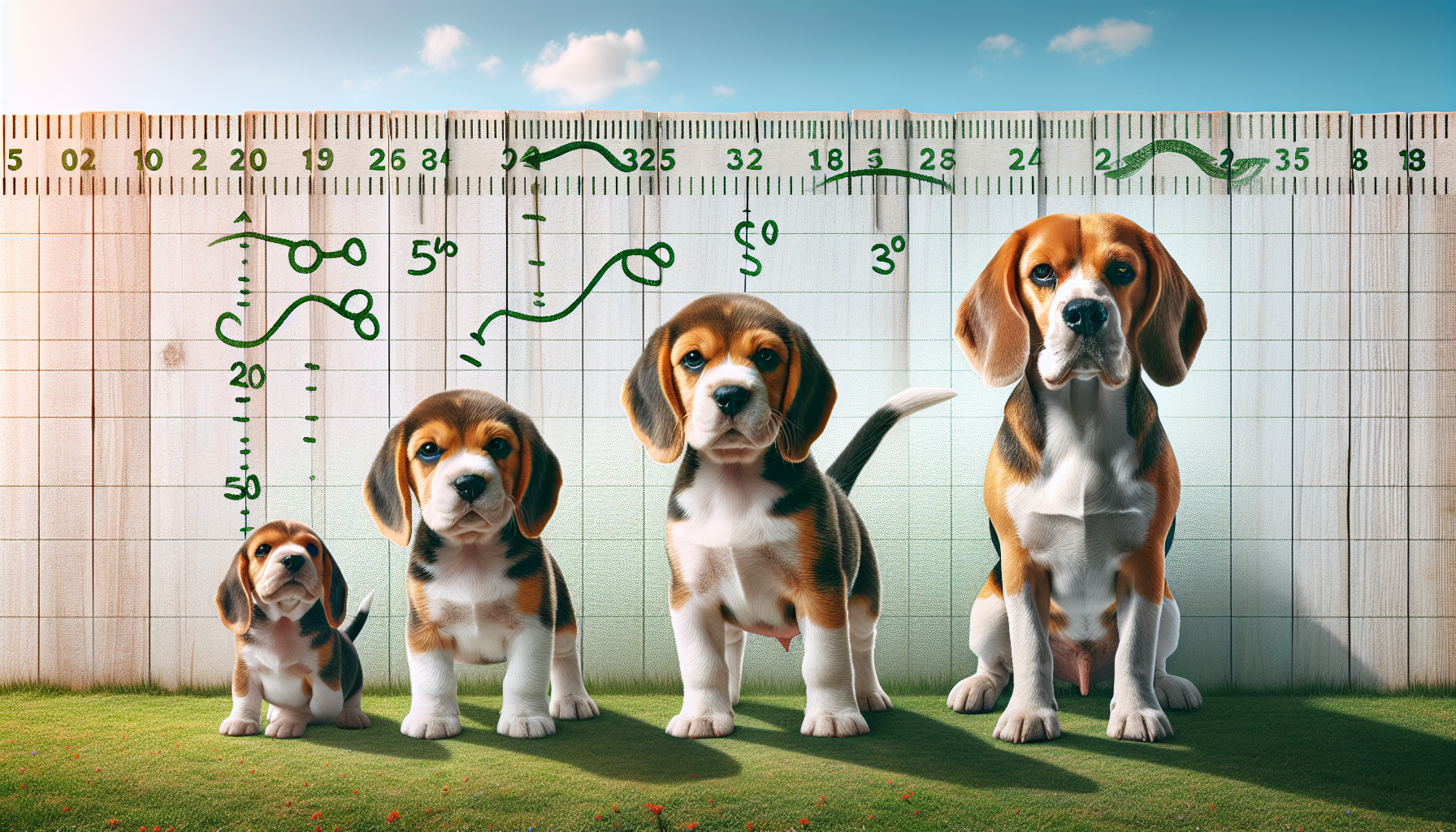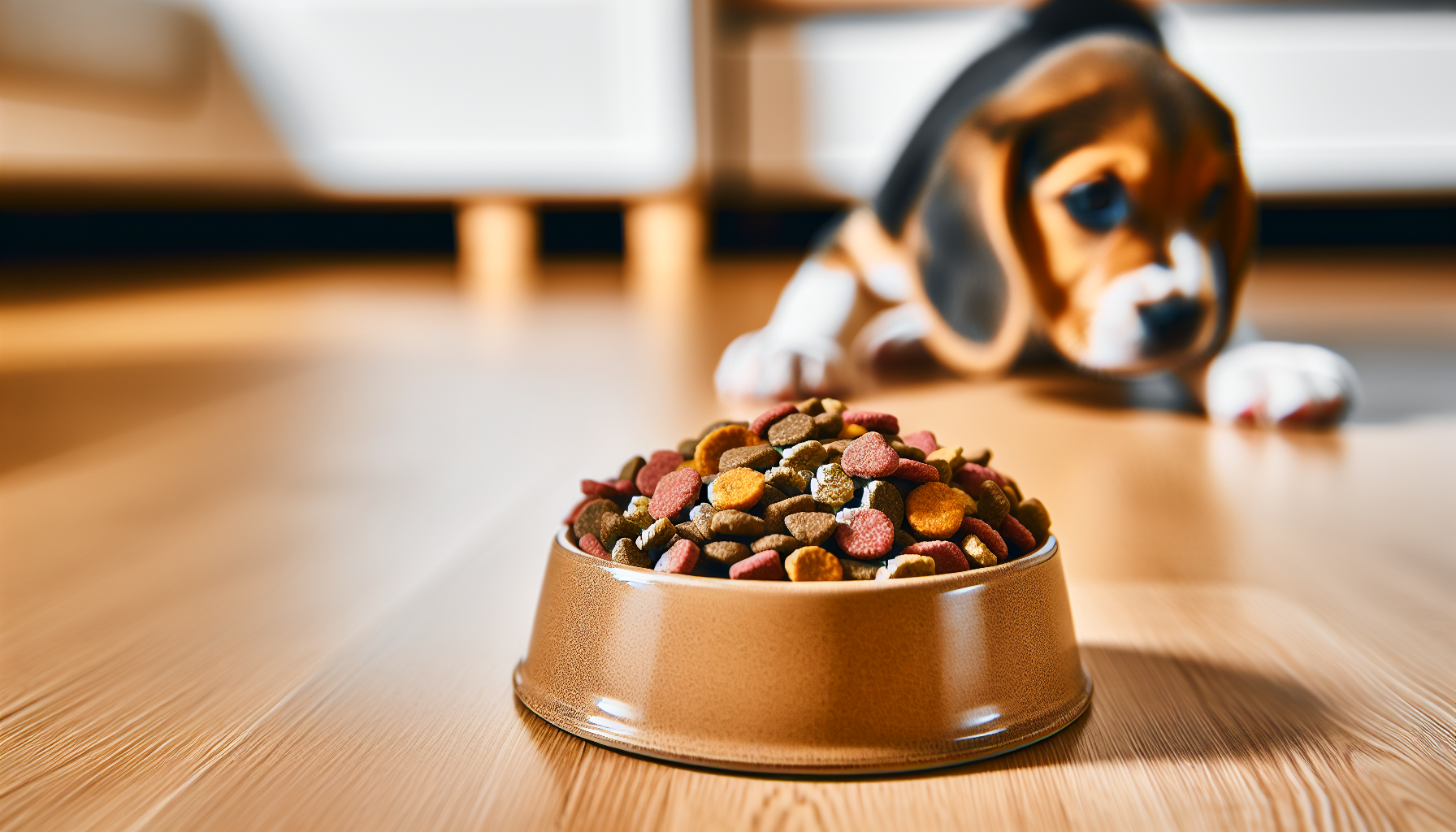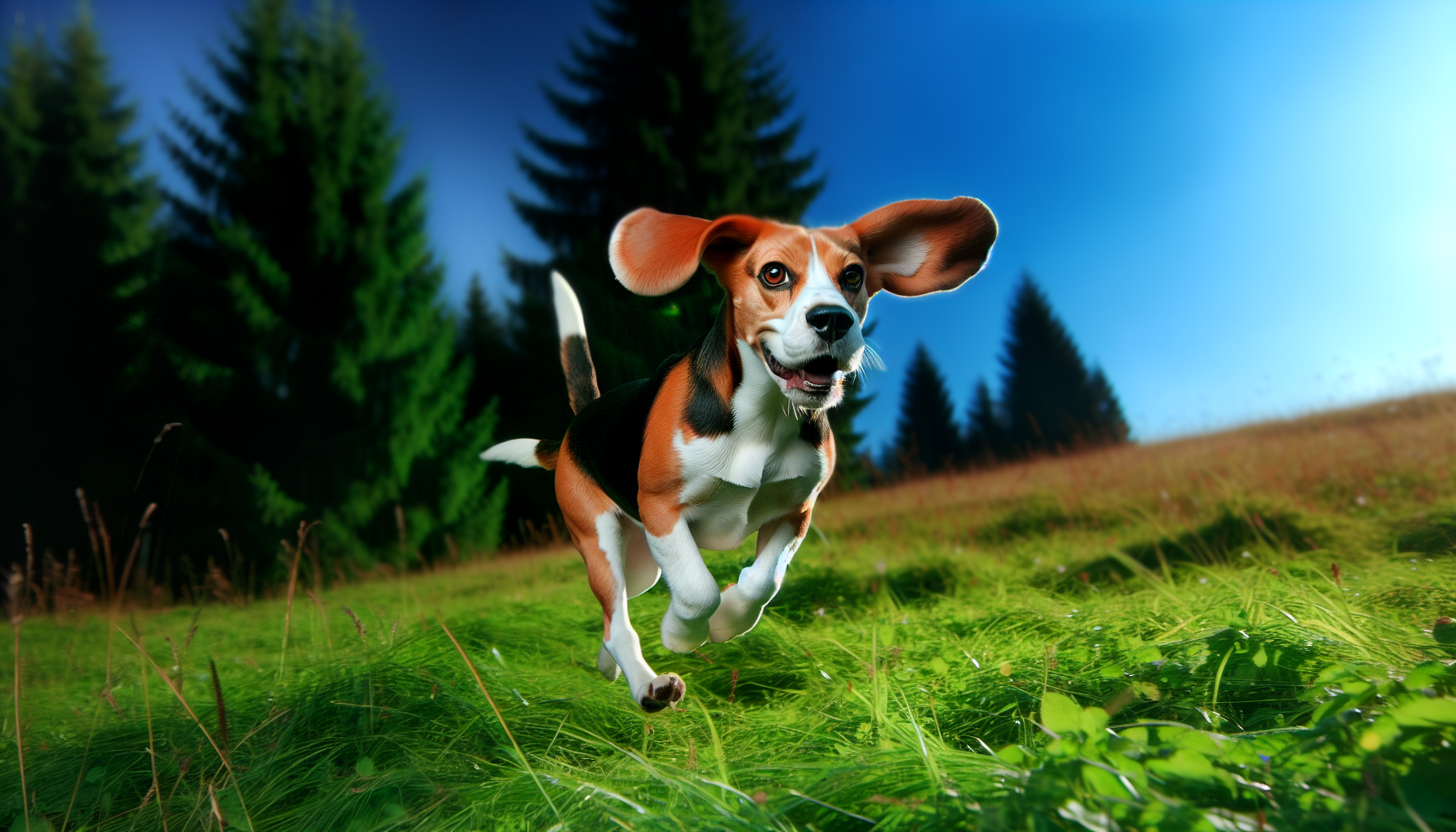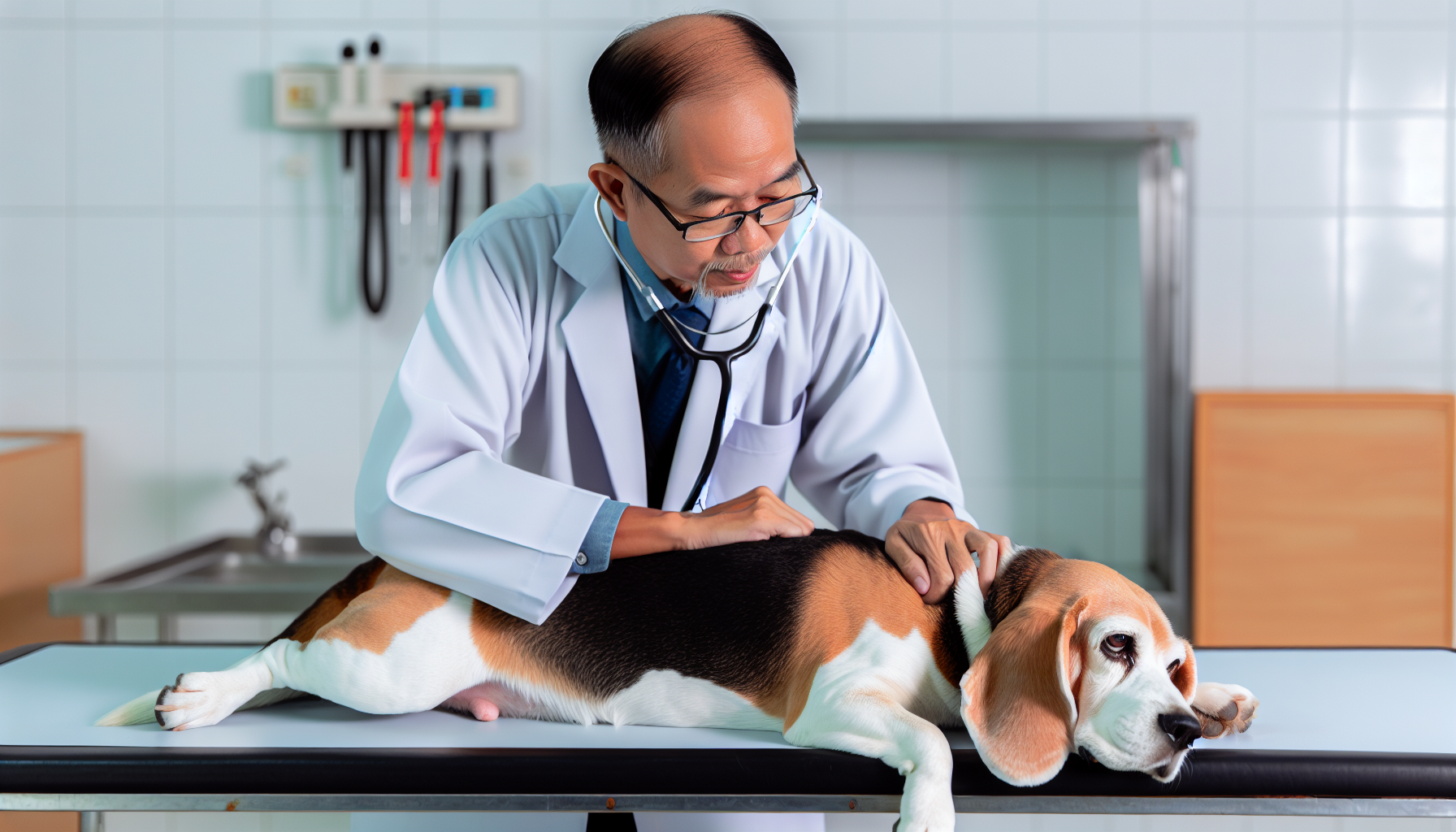Did you know that despite their similar appearances, Beagles can vary in size by up to 15%? This fascinating breed is categorized into two distinct size groups: those diminutive pooches standing under 13 inches, and their slightly loftier kin ranging from 13 to 15 inches in height. Understanding which size bracket your Beagle falls into is crucial—it's not just trivia, it’s about providing tailored care to meet their unique growth-related needs. This guide unearths the determinants of Beagle size, with topics ranging from the role of DNA to the impact of diet, all while offering practical tips that are easy to follow and won't bury you in a mountain of details.
Key Takeaways
- Beagles vary in size, with two recognized height categories (‘13 inches & under’ and ‘13 to 15 inches’), each with an ideal weight range to maintain health.
- A Beagle’s growth progress, adult size, and weight can be estimated using genetic cues, growth charts, and nutritional intake, with full maturity typically reached around 18 months.
- Proper nutrition, exercise, consistent veterinary care, and socialization play critical roles in healthy growth and development, with special considerations required for managing health issues and senior Beagle care.
Find out how to train your beagle to be the well-behaved pup you desire – Read Free Report
Understanding Beagle Size: A Comprehensive Overview

One of the first things you’ll notice about Beagles is their compact, solid, and balanced body, reminiscent of a miniature foxhound. These physical traits, reflecting their endurance in long chases, are a testament to their historical role as hunting dogs in England. But the question is, what factors contribute to a Beagle’s physical growth, and why is it important to understand them?
Age, gender, and proper care are the key drivers of a Beagle’s physical growth progress, including their beagle growth stages. It’s not just about reaching a specific weight target; it’s about prioritizing their health and well-being at every stage of their development. This approach ensures that your Beagle pup grows into a healthy, happy adult dog.
The Two Varieties of Beagle Sizes
When it comes to Beagles, size matters. Not all Beagles are the same size, and understanding this can give you a rough estimate of how big your puppy will grow. Beagles come in two size varieties: ‘13 inches & under’ and ‘13 to 15 inches tall’. Each of these sizes has an ideal weight range that supports healthy growth.
Ideally, a full-grown Beagle with a height of 13 inches or less should weigh 20 to 30 pounds. This weight limit is considered appropriate for the breed. In contrast, an adult Beagle standing between 13 to 15 inches tall should ideally weigh between 25 and 40 pounds. These numbers are not set in stone but offer a guideline to help you monitor your Beagle’s weight gain and ensure they maintain a healthy weight. Monitoring your Beagle’s weight is essential, and understanding the average beagle weight for their size can help you keep them in optimal health.
Predicting Your Beagle Puppies Adult Size
Predicting your Beagle’s adult size may feel like gazing into a crystal ball, but there are several reliable methods to estimate their eventual size. Genetics and the size of your Beagle’s parents play a significant role. However, some Beagles may still deviate from the expected size based on their genetic lines. Their growth is also significantly influenced by adequate nutrition.
You can accurately predict your Beagle’s adult size once they have reached full maturity, typically around a year and a half of age. To estimate their adult height, you can use the formula provided by the American Kennel Club: Height at 6 Months (inches) x 100 / 75 = Adult Height of a Beagle (approximation). It’s also worth noting that spaying or neutering your Beagle at an early age can impact their growth plates, potentially leading to them becoming larger and taller than they would otherwise.
Decoding the Beagle Growth Chart

The importance of a Beagle’s growth chart extends beyond mere numbers and lines; it serves as an invaluable tool for monitoring your dog’s progress. It offers guidance on the expected height and size of Beagles at different stages of development, providing insights into their growth progress, including weight gain and growth milestones.
Consistent growth with intermittent periods of rapid growth is a typical pattern for Beagles. However, growth issues may arise from overfeeding, underfeeding, or inadequate health maintenance during their puppyhood. By effectively utilizing a growth chart, you can compare their weight and height to standard benchmarks, ensuring they’re on the right track.
Stages of Beagle Puppy Growth
The journey from a pint-sized pooch to a full-grown Beagle is marked by various stages of growth, each with unique developmental milestones and weight changes. In the first two weeks of life, Beagle puppies are blind and deaf, depending entirely on their mother for care and nourishment.
As they grow, cats reach new milestones. Here are some key milestones to look out for:
- Around 7 to 8 weeks old, they learn important socialization skills from their mother and littermates and typically have a full set of baby teeth.
- By six months, they experience an increase in height and weight, reaching about 50% of their adult weight and height. Around this age, they also start experiencing growth spurts and plateaus, unpredictable periods that can either accelerate or decelerate the growing process.
- However, their physical growth starts to slow down around 10 months of age.
Tracking Your Beagle's Weight Gain
Beagles, like their human counterparts, can be susceptible to weight problems. However, unlike humans, they rely on their owners to keep their weight in check. Keeping tabs on your Beagle’s weight gain is crucial in ascertaining their healthy growth rate and that they are getting the necessary nutrition.
To determine if your Beagle is at a healthy weight, observe their physical condition. Factors such as overeating, lack of exercise, genetics, lifestyle, diet, and health conditions like Cushing’s disease, Cervical Intervertebral Disc Disease, and fluid retention can influence weight gain.
Here are some signs to look for:
- Ribs should be easily felt without excess fat covering them
- Waist should be visible when viewed from above
- Abdomen should be tucked up when viewed from the side
Regularly weighing them at home can help you keep track of any weight changes using a weight chart.
Nutrition's Role in a Beagle's Growth

The saying “You are what you eat” holds true for Beagles too. Nutrition significantly influences their growth, necessitating a balanced mix of nutrients for their optimal development. For a Beagle puppy, it’s important to ensure a balanced diet that includes:
- At least 40% protein-rich food like meat and fish
- 25% carbohydrates
- 25% vegetables
- 10% fruits
This will help support their overall health and growth.
For 7-month-old female beagles, two meals a day are recommended to maintain a balanced diet as they grow.
Choosing the Right Beagle Pup Food
Selecting the right puppy food from the vast array of options available can be daunting. However, a high-quality diet rich in dog nutrition includes:
- lean meats
- vegetables
- whole grains
- protein
- fat
can support your Beagle’s growth. For a 2-month-old Beagle, three meals per day are recommended.
Some top-rated puppy food brands recommended for Beagles include Pupper Fuel (Chicken Recipe), Stella & Chewy’s Wild Red Classic, and Blue.
Transitioning to Adult Dog Food
Just like children grow out of their toddler diets, Beagles too need to transition from puppy food to adult dog food at the appropriate age. This transition usually happens around 12-14 months of age but should ideally wait until they reach their adult size, which can be up to 18 months.
Transitioning should be done gradually over a period of 3 to 4 weeks to avoid stressing their digestive system. Once they become adults, Beagles generally need:
- 1.5 to 2 cups of high-quality dog food per day
- Split into two meals
- A well-balanced diet including high-quality protein, essential fats, digestible carbohydrates, vitamins, and minerals.
Some highly recommended brands for adult Beagle food include Zignature Turkey Limited Ingredient Formula Dry Food, Pupper Fuel, and Busy Beagles.
Exercise and Its Impact on Beagle Size

Beagles, known for their vivacity, greatly benefit from exercise in their growth process. Regular exercise helps them burn off energy and maintain a healthy weight, contributing to their overall size and development. Beagles can begin enjoying longer walks and should receive a minimum of an hour of exercise starting at 7 months old.
When they reach 11 months, they should ideally have 20 to 60 minutes of walk time each day, split into two sessions. However, owners need to be mindful of over-exercising their Beagle, as it can cause damage to their growth plates, which are essential for their development.
Balancing Playtime and Rest
While Beagles love to play, they also need their rest, just like us. Balancing playtime and rest is crucial to prevent obesity and promote healthy growth in Beagles. A Beagle puppy should have a minimum of 20 minutes of exercise, ideally 30 minutes, and some may need up to 40 minutes. Recommended types of play include:
- interactive toys such as puncture-resistant rubber toys that release treats
- chew toys
- tennis balls
- tug of war
It’s important to be mindful of overexercising your Beagle, as it can result in:
- sore muscles
- muscular pain
- stiffness
- a negative impact on their blood parameters
- hormone responses
- potentially interfere with bone growth in young dogs.
The Importance of Obedience Training
Obedience training is an essential part of a Beagle’s upbringing. It helps manage their energy levels and ensures they grow into well-behaved adult dogs. Obedience training ideally starts from the moment you adopt your Beagle, and they should be familiar with fundamental commands, including sit, stay, and come.
Positive reinforcement, such as using food rewards and attention, is the most effective method of obedience training for Beagles. It motivates them to learn and repeat desired behaviors, strengthens the bond between you and your Beagle, and contributes to their happy behavior, which is an important part of their development.
Health Factors Influencing Beagle Size

A Beagle’s size can be largely impacted by health-related factors. Beagles have a genetic predisposition to certain health issues, including cervical intervertebral disk disease, which involves pressure from an intervertebral disc on or around the spinal cord in the neck. These conditions can result in stunted growth in Beagles due to chronic pain or discomfort that impacts their overall health. Recognizing the symptoms of these conditions is important for seeking prompt veterinary care.
Consistent veterinary care is essential for their long-term health, enabling early detection of common health problems like diabetes or genetic disorders such as cervical intervertebral disk disease. A veterinarian can help prevent and manage health concerns, which is vital for ensuring your Beagle reaches their full growth potential.
Recognizing Signs of Growth Issues
Recognizing signs of growth issues in your Beagle allows for early intervention and proper care. Your Beagle might experience abnormal posture, bowed legs, severe obesity, painful joints, and difficulty walking among other symptoms if they’re facing growth issues. Stunted growth, in particular, might be indicated by slow or no growth, smaller size compared to other Beagles of the same age, and signs of malnutrition.
Nutritional deficiencies can also impact your Beagle’s growth. Indications may encompass:
- Dull, brittle coats
- Dry, flaky skin
- Lack of energy
- Excessive thirst
- Joint disease
- Weight loss
- Reduced appetite
- Diarrhea
It’s essential to monitor your Beagle’s health and consult with a vet if you notice any of these symptoms.
Managing Health Concerns
Managing health concerns such as genetic predispositions and injuries is essential for ensuring your Beagle reaches their full growth potential. Genetic disorders can have a significant impact on a Beagle’s growth and development, while injuries affecting the growth plate can result in malformation or improper ossification of the bone.
To effectively manage health issues, monitor your Beagle’s food intake and ensure a balanced diet. Here are some tips:
- Avoid fillers and additives
- Engage their hunting skills with creative feeding methods
- Consult your veterinarian for a possible prescription restricted-calorie diet if they become overweight.
Regular veterinary check-ups are vital for early detection and treatment of health concerns, providing recommendations on proper nutrition, exercise, and socialization to maintain their overall health.
Socialization and Its Effects on Growth
A Beagle’s growth is notably influenced by socialization. It ensures they develop into well-rounded, confident adults and helps prevent behavioral problems such as aggression and fearfulness, which can arise from a lack of early exposure to a variety of people, environments, and situations.
Effective socialization techniques for Beagle puppies include:
- Rewarding them for curiosity and calm behavior with treats, praises, and toys
- Arranging playdates with friendly dogs
- Exposing them to various environments and people
- Maintaining a consistent schedule
These techniques can help ensure that your female Beagle puppy, a popular dog breed, grows up to be well-adjusted and social.
It’s important to ensure that your Beagle puppy has received all three puppy vaccines before socializing with other dogs.
The Role of Positive Reinforcement
In dog training, positive reinforcement entails offering rewards like praise, food, or toys to motivate and reinforce preferred behaviors. It can motivate a Beagle to learn and repeat desired behaviors, strengthen the bond and trust between the Beagle and their owner, and contribute to their well-behaved and happy behavior, which is an important part of their development.
Common positive reinforcement techniques for Beagle’s include:
- Using food treats
- Praise
- Petting
- Favorite toys
- Games
These can be used as rewards for good behavior. It’s recommended to start using positive reinforcement in training a Beagle between eight and 16 weeks of age.
Preventing Fear and Aggression
Fear and aggression in Beagles, one of the many dog breeds, often stem from a lack of early socialization. Proper socialization can help prevent these behaviors, ensuring they grow into confident and friendly adult dogs. It enables them to develop effective communication with other dogs and people, enhances their problem-solving skills, and helps them cope with stress.
To prevent and manage fear and aggression in Beagles, techniques such as redirecting the dog’s attention away from stressors and employing counter-conditioning and desensitization strategies can be utilized to reduce their fear and anxiety responses.
When to Expect Full Maturity in Beagles
Beagles are typically considered fully mature at the age of 18 months, marking the point where their height growth generally ceases. However, their weight can continue to rise even after they reach 18 months, while their height typically remains unchanged after maturity. Several factors can affect the slowing down of growth in Beagles after 18 months of age, including:
- Nutrition
- Exercise
- Overall health
- Rare health conditions
- Genetics
- Sex hormones
Special Considerations for Senior Beagles
As Beagles age, they may require special care and attention, including adjustments to their diet and exercise routine. Senior Beagles have specific dietary needs, including a protein to carb to healthy fat ratio of 25-35% each, with a focus on meat-based protein, adequate fiber from vegetables, and healthy fats. It’s also important to consider calorie intake and potentially use lower caloric density food and low calorie edibles due to decreased metabolism.
Senior Beagles still require a minimum of 30 minutes of exercise daily to ensure their well-being and contentment. However, the intensity of the exercise may need to be reduced as they age. Regularly weighing them at home and observing for any changes in their physical condition can help you keep track of any weight changes and identify common health issues like:
- obesity
- ear infections
- allergies
- cherry eye
- epilepsy
- hypothyroidism
Summary
In conclusion, understanding your Beagle’s growth stages, nutritional needs, exercise requirements, and potential health concerns is crucial for their healthy development. Regular vet check-ups, a balanced diet, regular exercise, and proper socialization can ensure your Beagle grows into a healthy and happy dog. Remember, every Beagle is unique and may grow at a different pace. So, embrace their individuality and enjoy the joyous journey of watching them grow!
Frequently Asked Questions
How big is a full-grown beagle?
A full-grown beagle can stand 13 inches or less and weigh less than 20 pounds, or stand 13 to 15 inches tall and weigh between 20 and 30 pounds.
Is a beagle a small or medium dog?
Beagles are considered to be a medium-sized breed, typically weighing between 20 to 40 pounds and standing about 13 to 15 inches tall at the shoulder. They are not small dogs.
Are there 2 sizes of beagle?
Yes, there are two sizes of beagles: those standing under 13 inches at the shoulder, and those between 13 and 15 inches. Their sizes largely determine their healthy weight.
Is a beagle considered a large dog?
No, a beagle is not considered a large dog, as they are typically small to mid-sized hound breed, weighing 20-40 pounds.
What are the different sizes of Beagles?
Beagles come in two sizes recognized by the American Kennel Club: under 13 inches and 13 to 15 inches at the shoulder, and are known for their pleasing colors such as lemon, red and white, and tricolor.
Learn how to train your beagle to be the well-behaved dog you desire –> Access our Free Report
Shop for beagle-themed products and gifts that beagle enthusiasts will love.

